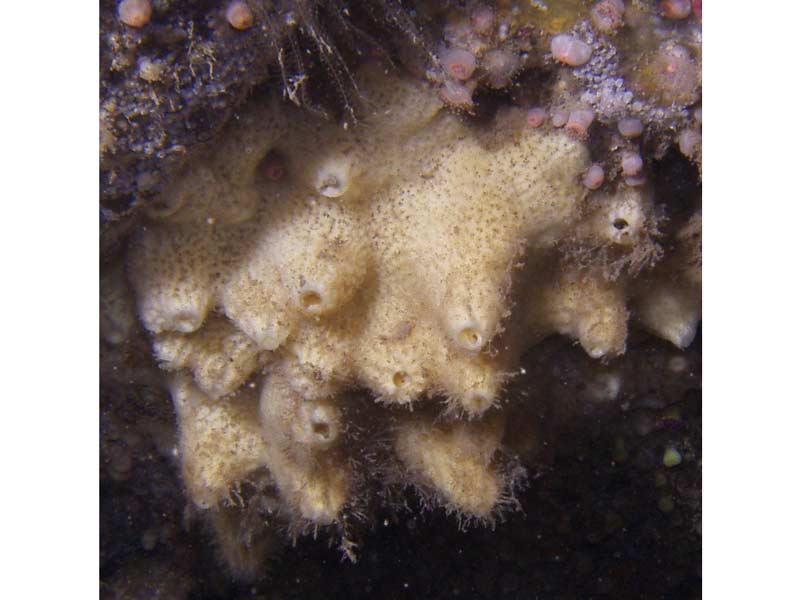Mudflat sponge (Haliclona (Reniera) cinerea)
Distribution data supplied by the Ocean Biodiversity Information System (OBIS). To interrogate UK data visit the NBN Atlas.Map Help
| Researched by | Al Reeve | Refereed by | Admin |
| Authority | (Grant, 1826) | ||
| Other common names | Redbeard sponge, Purple sponge, Purple encrusting sponge | Synonyms | Haliclona cinerea , Haliclona cinerea (Grant, 1826), Adocia cinerea |
Summary
Description
A soft, fragile sponge with an even, greyish light-brown or purple-brown colouration. It has few key external identification features. The sponge varies in shape from thin encrusting patches to laterally spreading masses of interconnecting branches and finger-like protrusions with large terminal exhalent pores(the 'oscules'). The surface of this sponge consists of a network of tissues with irregular spaces which gives a "loosely woven" appearance. The oscules on this species, regardless of location, lack the raised edge found in other members of this group. The oscules are irregularly scattered about the sponge and can be from a few centimetres to up to 25 cm in diameter in larger examples (van Soest, 2000; Picton & Morrow, 2000).
Recorded distribution in Britain and Ireland
Haliclona (Reniera) cinerea is present on the western coasts of England, Wales and Scotland and throughout the Shetland Isles. This sponge is also widespread around the coast of Ireland.
Global distribution
-Habitat
Haliclona (Reniera) cinerea is found at depths from around 10 m to 50 m. It is common under intertidal stones and in sheltered habitats with moderate to strong tidal currents. The tall finger-like form is only found in sheltered environments (Picton & Morrow, 2000).
Depth range
-Identifying features
- A soft and fragile sponge with a variable morphology.
- Can form encrusting sheets, rounded lobes, finger-like protrusions with large terminal oscules and spreading masses of anastomosing (interconnecting) branches.
- The surface has a "loosely woven" appearance.
- Sponge is greyish light-brown or purple-brown and coloured evenly.
- Oscules are at the terminus of protrusions or otherwise irregularly scattered.
- Oscules lack raised edges and range in diameter from a few centimetres to up to 25 cm.
- This species is differentiated from others by the morphology of its spicules
Additional information
Haliclona (Reniera) cinerea is distinguished from other species such as Haliclona rosea by internal characteristics such as the fine details of spicules. The slime strands from this species are also characterizing (see van Soest, 1977 and 2000).
Listed by
- none -
Bibliography
Bruce, J.R., Colman, J.S. & Jones, N.S., 1963. Marine fauna of the Isle of Man. Liverpool: Liverpool University Press.
Howson, C.M. & Picton, B.E., 1997. The species directory of the marine fauna and flora of the British Isles and surrounding seas. Belfast: Ulster Museum. [Ulster Museum publication, no. 276.]
JNCC (Joint Nature Conservation Committee), 1999. Marine Environment Resource Mapping And Information Database (MERMAID): Marine Nature Conservation Review Survey Database. [on-line] http://www.jncc.gov.uk/mermaid
Picton, B.E. & Costello, M.J., 1998. BioMar biotope viewer: a guide to marine habitats, fauna and flora of Britain and Ireland. [CD-ROM] Environmental Sciences Unit, Trinity College, Dublin.
Picton, B.E. & Morrow, C.C., 2000. Encyclopaedia of Marine Life of Britain and Ireland. http://www.habitas.org.uk/marinelife/index.html, 2003-09-18
Van Soest, R. W. M., 1977. Marine and freshwater sponges (Porifera) of the Netherlands. Zoologische Mededelingen, 50, 261-273.
Van Soest, R.W.M., Picton, B. & Morrow, C., 2000. Sponges of the North East Atlantic. [CD-ROM] Windows version 1.0. Amsterdam: Biodiversity Center of ETI, Multimedia Interactive Software. [World Biodiversity Database CD-ROM Series.]
Datasets
Centre for Environmental Data and Recording, 2018. Ulster Museum Marine Surveys of Northern Ireland Coastal Waters. Occurrence dataset https://www.nmni.com/CEDaR/CEDaR-Centre-for-Environmental-Data-and-Recording.aspx accessed via NBNAtlas.org on 2018-09-25.
Kent Wildlife Trust, 2018. Kent Wildlife Trust Shoresearch Intertidal Survey 2004 onwards. Occurrence dataset: https://www.kentwildlifetrust.org.uk/ accessed via NBNAtlas.org on 2018-10-01.
Manx Biological Recording Partnership, 2022. Isle of Man historical wildlife records 1990 to 1994. Occurrence dataset:https://doi.org/10.15468/aru16v accessed via GBIF.org on 2024-09-27.
NBN (National Biodiversity Network) Atlas. Available from: https://www.nbnatlas.org.
OBIS (Ocean Biodiversity Information System), 2025. Global map of species distribution using gridded data. Available from: Ocean Biogeographic Information System. www.iobis.org. Accessed: 2025-07-26
South East Wales Biodiversity Records Centre, 2023. SEWBReC Marine and other Aquatic Invertebrates (South East Wales). Occurrence dataset:https://doi.org/10.15468/zxy1n6 accessed via GBIF.org on 2024-09-27.
Citation
This review can be cited as:
Last Updated: 22/01/2007



